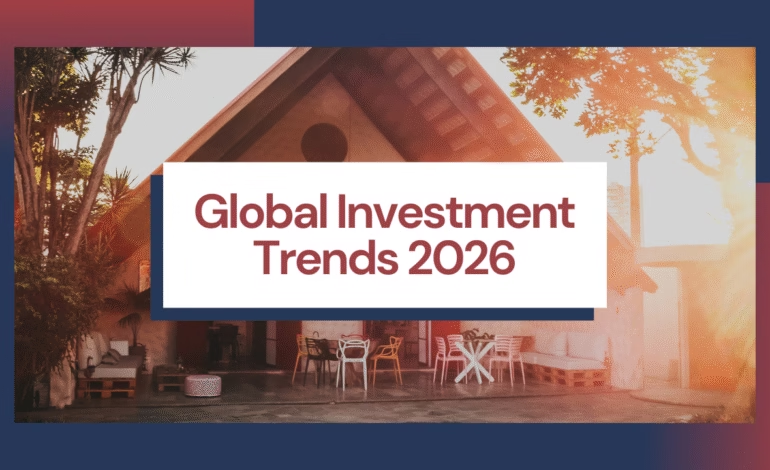
Why 2025 is a Defining Year for Investors
If you have been closely following the financial world, you know that every few years a new wave of opportunities reshapes the global markets. Think about how tech stocks dominated in the early 2000s, how cryptocurrencies surged in the 2010s, and how sustainable energy became a central investment theme in the 2020s. Now, as we step into 2025 and beyond, the pace of change is accelerating like never before.
So, what are the most exciting investment opportunities 2025? Where should investors in the US, UK, Canada, Singapore, and Australia look if they want to ride the next wave of wealth creation? And most importantly, how will the future of global investing look by 2026 and the following years?
In this blog, I’ll break down the top global investment trends 2025 & beyond, backed by data, real-world case studies, and expert predictions. I’ll also ask you some questions along the way, and you can imagine answering them in the comments like a discussion forum.
The Rise of Technology-Driven Investments
When we talk about global investment trends 2026, one area always sits at the top of the list: technology. But the story isn’t just about big tech companies anymore. It’s about emerging technologies that are reshaping industries.
Artificial Intelligence (AI) Beyond Hype
We’ve all seen how AI tools like ChatGPT and MidJourney disrupted workflows in 2023 and 2024. But the real investment wave in 2025 comes from AI integration into every sector.
- Healthcare: AI is helping doctors predict illnesses earlier. Imagine investing in biotech startups that use AI for early cancer detection.
- Finance: AI-driven funds are already outperforming some traditional hedge funds.
- Education & Training: Personalized AI tutors are projected to make edtech a $400B industry by 2030.
According to McKinsey research, AI adoption could unlock up to $4.4 trillion in productivity gains globally by 2030.
Quick Quiz for you:
If you had $10,000 today, would you put it in an AI ETF (exchange-traded fund), or would you prefer picking an AI healthcare startup?
Drop your choice in the comments: ETF or Startup?
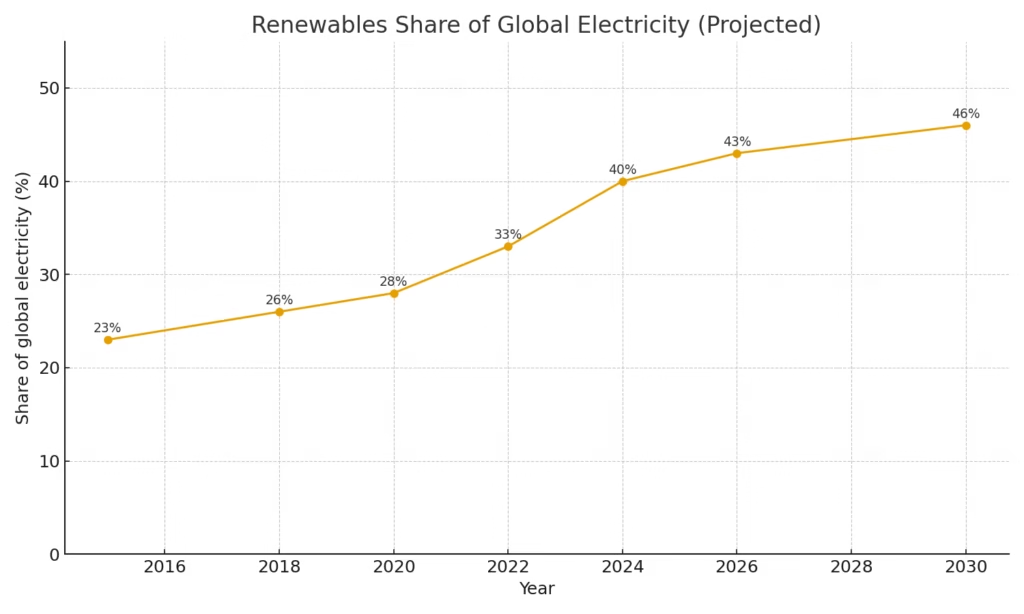
If you’re looking for budget-friendly exposure, several low cost mutual funds for developed market growth in 2025 already include renewable energy ETFs as part of their allocation.
Clean Energy and Green Tech
The future of global investing is not just about profits; it’s about sustainability. Tier 1 countries like the US and the UK are aggressively funding green hydrogen, solar storage, and electric mobility.
For example, Australia is positioning itself as a global leader in lithium mining (critical for EV batteries). Singapore, on the other hand, is pouring investments into smart energy grids.
Investment case:
- Tesla’s Gigafactories are not just making cars; they are turning into energy hubs.
- Startups in carbon capture are being funded heavily in Canada.
If you’re looking at investment opportunities 2025, green energy ETFs, renewable infrastructure funds, and direct investments in EV supply chains are must-watch. The International Energy Agency projects that renewables will account for nearly half of the world’s electricity by 2030, reinforcing the case for long-term investment in clean energy funds.
Cybersecurity: The Silent Growth Engine
With AI and digitalization comes a growing risk: cyber threats. From ransomware to state-sponsored attacks, cybersecurity has now become as critical as energy and healthcare.
- Global cybersecurity spending is expected to exceed $300B by 2026.
- Major players like Palo Alto Networks and CrowdStrike are expanding globally.
- Startups in quantum encryption could be the next trillion-dollar opportunity.
Think about it this way: Every company going digital needs protection. This makes cybersecurity one of the most stable and high-growth global investment trends 2026.
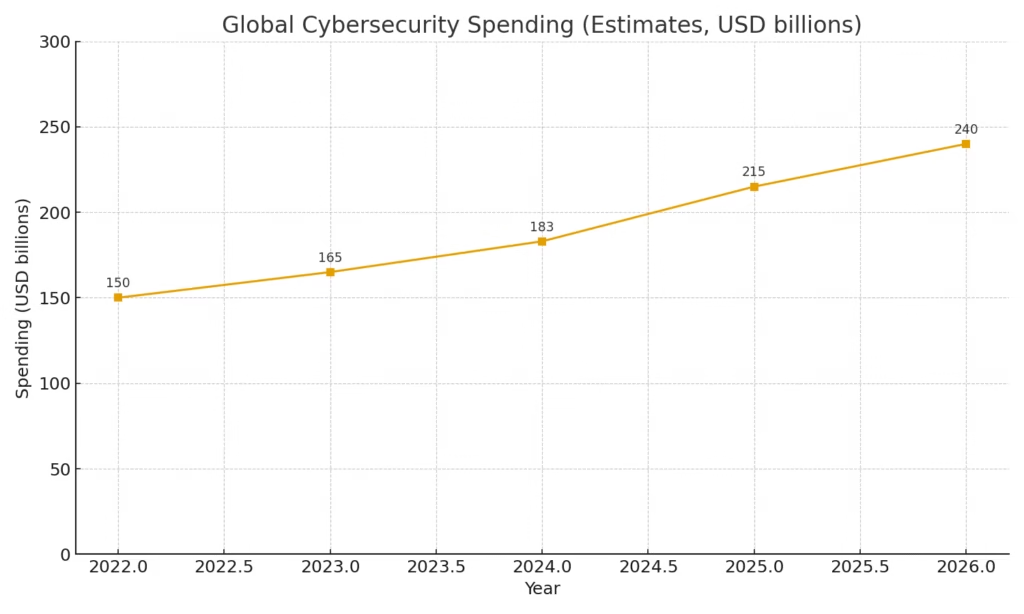
The Rise of Emerging Markets in 2025
If you’re based in the US, UK, Canada, or Australia, it’s easy to think most innovation comes from your backyard. But here’s a secret: the fastest-growing investment opportunities 2025 are often in emerging economies.
For instance:
- India: Now the world’s most populous country, India is seeing explosive growth in fintech, renewable energy, and consumer markets. Goldman Sachs projects India’s stock market to be among the top three globally by 2030.
- Vietnam & Indonesia: Known as the “next manufacturing hubs,” these countries are benefiting from supply chain diversification away from China.
- Africa: Countries like Nigeria and Kenya are at the forefront of mobile banking and digital payments, leapfrogging traditional banking models.
For investors curious about passive income generation, visit our guide to 10 proven passive income ideas that actually work.
Question:
If you were choosing between investing in an Indian renewable energy ETF or a Vietnamese manufacturing ETF, which would you pick for the next 5 years?
Drop your answer in the comments: India or Vietnam?
Digital Assets: Beyond Cryptocurrencies
When most people hear digital assets, they immediately think of Bitcoin and Ethereum. But in 2025, the future of global investing in this space is much broader.
- Tokenized Real Estate: Imagine buying a share of a luxury condo in New York or Singapore for just $1,000, thanks to blockchain tokenization. This makes real estate more accessible to retail investors globally.
- Central Bank Digital Currencies (CBDCs): Countries like China are already testing digital yuan, and even the European Union is accelerating digital euro plans. These will reshape how cross-border payments work.
- DeFi (Decentralized Finance): The hype of 2020 – 2021 has matured into more stable models. Investors can now earn passive yields through regulated DeFi platforms.
For Example:
In Canada, a group of investors pooled funds to buy a fractionalized token of farmland, which they now lease out for steady annual returns. That’s digital transformation meeting traditional assets.
Geopolitical Influences on Investment Opportunities
The world isn’t just shaped by innovation; it’s shaped by politics and conflicts. If you’re serious about understanding global investment trends 2026, you must pay attention to geopolitics.
- US-China Rivalry: Technology restrictions, tariffs, and supply chain disruptions create both risks and opportunities. For example, US semiconductor companies are investing in domestic chip factories, while Southeast Asia benefits as production shifts away from China.
- Energy Security: Europe’s energy crisis in 2022 – 2023 taught investors the importance of energy independence. In 2025, countries are doubling down on green hydrogen and nuclear energy projects.
- Global Conflicts: Defense stocks often surge during instability. Companies producing drones, cybersecurity solutions, and AI-powered defense systems are gaining investor attention.
Quiz:
If you had to pick one sector to invest in based on geopolitical shifts, would you choose defense technology, semiconductors, or green energy?
Share your choice in the comments below.
The Wealth Shift: From West to East
One of the most under-discussed but powerful trends is the wealth shift from Western economies to Asia and the Middle East.
- The Middle East, traditionally an oil-dependent region, is diversifying into tourism, tech hubs, and green energy projects. Saudi Arabia’s Vision 2030 project is a clear example of this transformation.
- Singapore is becoming a global hub for family offices, with ultra-high-net-worth individuals parking billions in its financial markets.
- Meanwhile, China continues to influence commodity markets, renewable energy prices, and digital payments adoption.
For investors in the US, UK, or Australia, this means diversification is not optional anymore; it’s essential.
Practical Scenarios for Investors in 2025
Let’s play out some real-world scenarios to help you think like an investor:
Scenario 1: The Tech-Sustainability Hybrid Investor
You allocate 40% to AI and clean tech ETFs, 30% to emerging market equities (India and Vietnam), 20% to tokenized real estate, and 10% to cryptocurrencies. This portfolio balances innovation with global growth.
Scenario 2: The Conservative Global Growth Investor
You invest in dividend-yielding infrastructure projects in the US and Canada, allocate some funds to Singapore REITs (real estate investment trusts), and add green energy ETFs from Europe. This provides stability with steady long-term returns.
Scenario 3: The Risk-Taker
You go heavy on blockchain-based DeFi, early-stage African fintech startups, and quantum computing companies. The upside is massive, but so is the risk.
Quick Questions for you:
Which investor type do you see yourself as? Hybrid, Conservative, or Risk-Taker?
Let me know in the comments section.
Understanding the Psychology of Investing in 2025
Markets aren’t just shaped by data, technology, or government policy. They’re shaped by people. And people are emotional. Even the most experienced investors in the US, UK, or Australia are influenced by fear and greed.
- In 2020, fear drove investors to sell during the pandemic crash, only to miss the recovery.
- In 2021, greed pushed millions into meme stocks and cryptocurrencies at inflated valuations.
- In 2023–2024, a balanced mindset returned, where diversification and fundamentals became more important again.
For 2025 and beyond, smart investors are learning to ask: Am I reacting emotionally, or am I making rational, long-term choices?
Question:
Do you think you are more of a fear-based investor (too cautious) or a greed-based investor (chasing trends)?
Comment with “Fear” or “Greed” and let’s see what kind of community we have here.
Predictions for Global Investment Trends 2026 and Beyond
Now let’s project forward. What does the future of global investing look like in the next 5 to 10 years? Here are some expert-backed predictions:
- Decentralized Finance Integration with Banks
By 2026, expect large banks in the US, Canada, and Singapore to integrate DeFi tools into mainstream banking apps. Investors will earn yields directly from digital assets with regulated safeguards. - Artificial Intelligence Becomes an Asset Class
Instead of just being part of tech funds, AI companies will be grouped as a separate investment category, much like biotech or energy today. - Carbon Credits as Tradable Assets
With governments worldwide cracking down on emissions, carbon credits could become a multibillion-dollar trading market. Investors in green tech will benefit not only from stock appreciation but also from carbon-linked returns. - Geopolitical-Driven Diversification
Investors will increasingly spread money across continents, not just asset classes. For example, a UK investor may balance portfolios with US bonds, Singapore REITs, and Indian tech stocks to hedge geopolitical risks. - Democratization of Investing
Fractional shares, tokenized real estate, and AI-driven robo-advisors will make sophisticated portfolios available to retail investors for as little as $100.
How to Build a Resilient Portfolio in 2025
With all these opportunities, how do you actually build a portfolio that balances risk and growth?
Step 1: Diversify Across Sectors
- Allocate part of your funds to AI and technology ETFs.
- Add green energy and infrastructure funds for stability.
- Keep a small percentage (5 to 10%) in digital assets for long-term growth potential.
Step 2: Diversify Across Regions
- US and UK remain strong for blue-chip stocks.
- Asia (India, Vietnam, Singapore) offers higher growth.
- Canada and Australia are rich in commodities and clean energy opportunities.
Step 3: Balance Short-Term and Long-Term Bets
- Short-term: Dividend-paying REITs, bonds, or infrastructure funds.
- Long-term: AI-driven startups, tokenized assets, or emerging markets.
Practical Tip: Always keep a portion in cash or liquid assets. In uncertain markets, cash gives you flexibility to seize new opportunities.
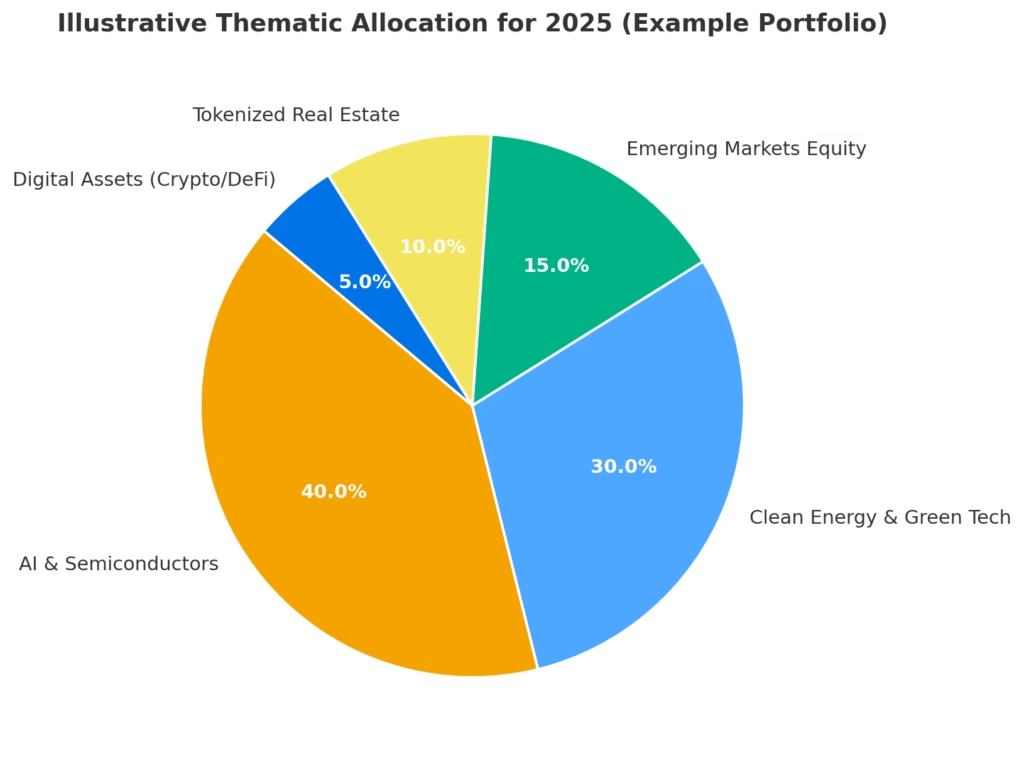
Real-Life Example: Sarah’s Portfolio in 2025
Sarah, a 35-year-old professional in Toronto, has $50,000 to invest. She divides it like this:
- $20,000 in AI and clean tech ETFs (future growth).
- $10,000 in Canadian and Australian renewable energy projects (stability + dividends).
- $10,000 in Indian equity funds (emerging market growth).
- $5,000 in tokenized real estate in Singapore (alternative asset).
- $5,000 in Bitcoin and Ethereum (long-term hedge).
Her strategy balances innovation, stability, and diversification. This type of portfolio reflects the future of global investing that we’re discussing in this blog.
Common Mistakes to Avoid in 2025 Investing
- Overconcentration: Putting all your money into AI stocks or crypto can be risky.
- Ignoring Geopolitics: Not factoring in global conflicts or trade restrictions could reduce returns.
- Following Hype Without Research: Always check fundamentals, not just social media buzz.
- Timing the Market: Even experts can’t perfectly time entry and exit. Focus on long-term compounding.
Key Takeaways for Investors
- Investment opportunities 2025 are broader than ever, spanning AI, green tech, emerging markets, and digital assets.
- Global investment trends 2026 will likely be shaped by sustainability, digitalization, and geopolitics.
- The future of global investing is democratized, diversified, and technology-driven.
If you’re a retail investor in the US, UK, Canada, Singapore, or Australia, your success depends on how well you adapt to these shifts.
Quiz:
Let’s wrap up with one last challenge. Imagine you have $25,000 to invest right now. Which allocation would you choose?
- Option A: 50% AI + 30% Clean Energy + 20% Crypto
- Option B: 40% Emerging Markets + 40% US Blue-Chip Stocks + 20% Tokenized Real Estate
- Option C: 60% Green Infrastructure + 20% AI + 20% Bonds
Drop “A”, “B”, or “C” in the comments. There’s no wrong answer, but it’ll be fascinating to see how different investors approach the same amount of capital.
| Trend | What It Means | 2025-2030 Outlook | Leading Regions | Example Investment Options | Risk Level |
|---|---|---|---|---|---|
| Artificial Intelligence (AI) | AI is moving beyond hype into healthcare, finance, and education | Could unlock ~$4.4T in productivity; AI chip market ~$475B by 2030 | US, China, EU | AI ETFs, Nvidia, Microsoft, AI startups | Medium-High |
| Renewable Energy & Green Tech | Solar, wind, storage, EVs, and hydrogen growth accelerate | Renewables expected to reach ~46% of global electricity by 2030 | US, EU, China, India, Australia | Clean energy ETFs, green bonds, lithium mining stocks | Medium |
| Cybersecurity | Protecting digital systems from rising threats | Spending to exceed $200B annually by 2025 | US, UK, Singapore | Cybersecurity ETFs, Palo Alto, CrowdStrike | Low-Medium |
| Tokenized Real Estate | Blockchain fractional ownership of properties | Could reach ~$4T by 2035 (from <$0.3T today) | US, Singapore, UK | Tokenized real estate platforms, REIT hybrids | High |
| CBDCs & Digital Payments | Governments rolling out central bank digital currencies | 90%+ of central banks testing pilots | China, EU, India | Fintech stocks, digital payment ETFs | Medium |
| Semiconductors & AI Chips | Growing demand for AI-powered hardware and fabs | AI chip market ~$475B by 2030 | US, Taiwan, South Korea | Semiconductor ETFs, TSMC, ASML | Medium-High |
| Emerging Markets Growth | India, SE Asia, and Africa rising in fintech, manufacturing | India GDP projected 6.4% in 2025 | India, Vietnam, Indonesia, Nigeria, Kenya | EM ETFs, country funds | Medium-High |
| DeFi & Crypto | Regulated decentralized finance and institutional adoption | Institutional ETFs and stable DeFi platforms growing | US, Europe, Asia | Bitcoin ETFs, Ethereum, DeFi projects | High |
| Carbon Markets & Offsets | Trading carbon credits and offsets for net-zero targets | Carbon pricing mobilized >$100B in 2024 | EU, China, North America | Carbon ETFs, ESG funds | Medium-High |
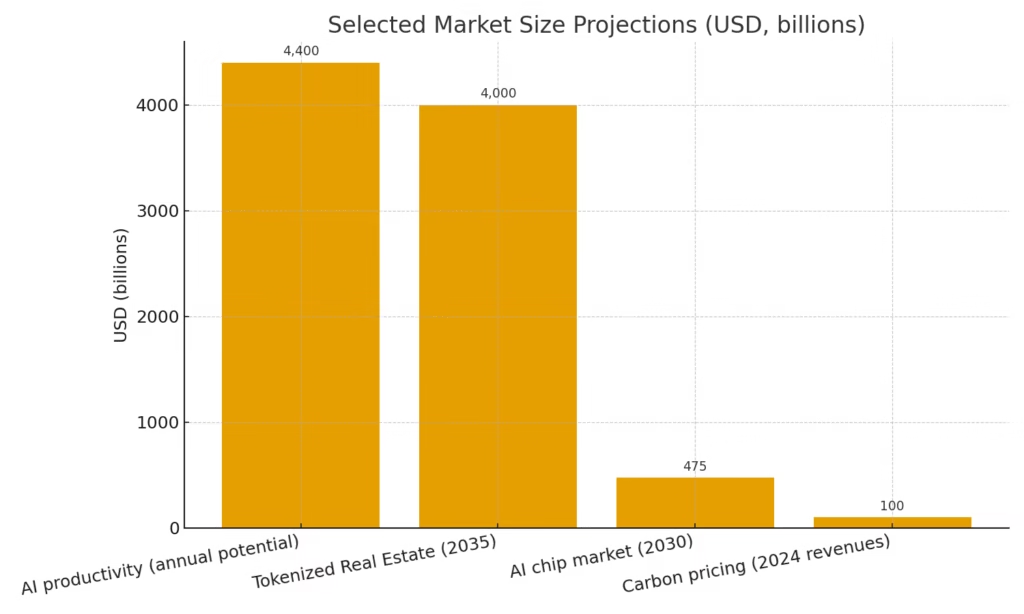
My Final Thoughts
The global investment trends 2025 and beyond remind us that investing is no longer just about Wall Street or the London Stock Exchange. It’s about AI in healthcare, solar farms in Australia, fintech in Africa, and tokenized real estate in Singapore.
The future of global investing belongs to those who embrace technology, stay globally diversified, and keep emotions in check. Whether you’re a cautious investor, a bold trend-chaser, or somewhere in between, the opportunities are there waiting for you.
Now the question is: Are you ready to seize them?



